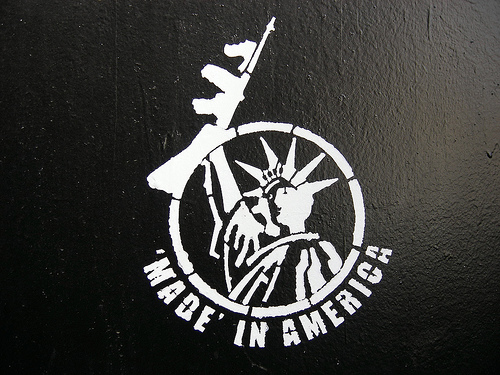
Sturdy, Liberty (edit – with the exception of their Centurion 20), and Fort Knox are just a few gun safe manufacturers who pride themselves in producing 100% American-made products. Assuming you’re an American, buying a gun safe (or any product for that matter) made in the good ole’ U-S-of-A kind of makes you feel good inside – like you’re serving your country or something.
I get a little extra burst of joy out of supporting American companies myself, but I’ll be the first to admit that I don’t do it exclusively. Take my history of car ownership for example: I’ve driven my share of fine American automobiles, but I didn’t hesitate to stray from domestication when I found a great deal on a used Toyota Sequoia. Does that make me a bad American? Perhaps, but it also makes me a happy driver.
Regardless of the market, buying products made in the USA has some lovely, often intangible perks, but does it always give you the best bang for your buck? I wanted to know the answer to this question, particularly how it pertains to the gun safe industry, so I sat down [on my couch and talked on the phone] with Terry Pratt, owner of Sturdy Gun Safe Manufacturing to find out.
I specifically sought out Terry for a couple of reasons. One, his company, Sturdy Safe, has been manufacturing American-made gun safes for over half a century, and Terry himself has been in the game since he was a teenager.
And two, though I’d never talked with him before, he seemed like the most approachable of his peers; since I started Gun Safe Haven over a year ago, I’ve spent a lot of time talking to customers, reading spec sheets and reviews of dozens of different safe manufacturers, and I’ve always gotten exceptional feedback from Sturdy Safe owners – honestly – nothing but praise on their product, prices, and flawless BBB customer service record. In addition, their website is incredibly informative. They’re like the Progressive auto insurance of the safe world – they’ll help you find the best deal on a gun safe, even if you don’t buy from them.
Though Terry lent me a solid hour of his time, it only took me a couple minutes to figure out that he’s a genuinely nice guy who has an honest-to-goodness passion for the industry. While I would have loved to have picked his brain for several more hours, I had an agenda, and I’m sure he had better stuff to do ;). That said, he was able to give me the information I needed to determine that American-made gun safes are indeed worth the hype (especially if you’re an American).
What makes a great safe so great? Well, a lot of things really, but one indicator they all have in common is sound structural integrity, and that all starts with a solid steel body. So, one of my first questions to Terry was how American steel stacks up to the rest of the world in quality. After all, when it comes to steel production, the United States is far from king of the hill in overall volume – according to the World Steel Association’s 2009 statistics measuring crude steel production, we’re behind Russia, Japan, the European Union, and China. In fact, China produces nearly 10 times the amount that we do…but is it any good?
According to Terry, “the problem with Chinese steel is that it’s inconsistent. You can’t rely on the chemistry, especially when using high tensile strength. The formula has to be right, and they’re just not there yet.”
Chinese and Mexican-produced steel just isn’t reliable for Sturdy Safe’s operation. With American steel, they’re able to bend it and work with it to match the form of their tried-and-true design. A lot of foreign steel, particularly that produced in China and Mexico, is unreliable, and often fractures under the strain applied during safe construction.
While China and our friends south of the border produce a significant amount of the steel used to supply American-based gun safe companies, they definitely aren’t the only countries in the security market. In fact, when it comes to steel, Terry said, “the Japanese have it right on the mark”.
So, if the quality of Japanese steel is so fantastic, why doesn’t Sturdy safe use it to manufacture their products? I’m sure Terry could answer that question 10 different ways, but one of the biggest reasons is that its high price and the added cost of US tariffs on steel imports make it way too expensive. The quality of American steel is on par with Sturdy’s high standards, keeping the cost significantly lower than the Japanese alternative (this ultimately passes more value on to the customer).
If safe manufacturers like Sturdy can turn a profit by producing their products from American steel, why would anyone want to outsource to Mexico or China? Aren’t they getting nailed with the steel tariffs? Not exactly – those same tariffs don’t apply to completed products. Many US gun safe manufacturers save a lot of money creating their products overseas, using cheap foreign steel and labor, and selling the final product back here in the States.
Well-established companies who keep their manufacturing within the country are able to stay competitive because they have certain advantages that most fresh-faced companies don’t. Sturdy Safe, for instance, has been in the business forever, they own nearly all of their capital (property included), and their storage space and operating revenue are high enough for Terry to load up on inventory while prices are low, and wait to use it when he needs it. Terry said, “In the old days, you could make a lot of money in manufacturing if you worked hard…nowadays, you’d have to have a hole in your head [to start from scratch]”. This is why a lot of new companies go outside the border to get the job done…it’s just too dang tough to stick around.
How is foreign manufacturing reflected in the final product? Based on the feedback I received from Mr. Pratt, it reflects rather poorly – at least well below Sturdy’s standard. It’s not uncommon to find inconsistencies between what the advertisement says, and what the customer actually gets when they buy the product.
When you’re producing a product overseas for the sake of cheap labor, it’s not uncommon to wind up with a cheap product. Terry has been designing, constructing, testing, and repairing safes and locking mechanisms for decades, and not just Sturdy products – he’s had his hands on all sorts of fun stuff. He told me a few stories about safes he’s worked on that would make you feel rather…unsafe.
For instance, safes that don’t measure up to their advertised steel thickness, and when it comes to steel on a security container, every fraction of an inch is significant (the price tag included). A lot of foreign products also lack the innovative design needed to keep up with the burglar-of-today’s constantly evolving break-in techniques. For instance, he mentioned a safe he was working on that had a 1/4″ steel door, framed with only 16 gauge holding the locking lugs. While the surface of the door might be able to take a good beating, a thug with a pry bar could rip that sucker right off. In addition, he’s also been able to spot a lot of exploitable locking systems – the result of poor design and shoddy craftsmanship.
All that considered, Terry will be the first to tell you that there are always exceptions – American manufacturers occasionally share some of the same aforementioned issues, and on the flip side, there are foreign manufacturers who’ve put out quality products. That said, the general consensus is that the quality of the safe tends to suffer when the work is done beyond US borders.
**On a side note, much to the dismay of my curiosity, Terry withheld the names of the offending manufacturers referenced above…he’s clearly a man of integrity.
The main intent of my phone call was to find out if American gun safes really boast superior quality to their foreign counterparts, and while it turns out they do, something else was also brought to my attention – just how many American jobs are supported in the process. Obviously, the Sturdy Safe employees see direct benefits, but it goes a whole lot farther than that.
Also effected are the mill workers, the folks in the leveling plant, the outside vendors who manufacture the plating, locking lugs, ceramic wool, insulating blankets, and of course, all the trucking that’s required to tie the whole thing together. A couple thousand American jobs have a hand in Sturdy Safe’s operation, and the number swells dramatically when you factor in the rest of the US-based gun safe manufacturers.
The United States has one of the largest consumer bases in the world for manufactured goods, but the number of jobs linked to manufacturing has dropped radically in just the last few years. The soapbox I’m standing on wasn’t built to hold my 260 lbs frame, so I’ll get off, but it’s definitely something to consider (if you’re reading this and you aren’t from the US and/or you just plain hate us, that point might not have the desired effect).
Regardless of how you feel about the last note, I can feel confident when I say that across the board, American made gun safes are definitely worth the hype.
I’d like to thank Terry Pratt, owner of Sturdy Safe Gun Safe Manufacturing once more for volunteering his time and expertise to supply me with the info I needed to write this post. As always, to anyone reading, I’d love to get your feedback. Stay safe!

 Follow
Follow

DO your home work browning are made in China.
ReallyDude,
You’re right – I implied in my opening sentence that 100% of Browning safes are American made. Though Browning products aren’t at all the focus of this article, I still should have taken the time to be more accurate, and not lumped them in with Sturdy and Ft Knox. As soon as I finish this comment, I’ll edit the sentence in question, and take your advice to do my homework better next time.
Thanks for the catch – feedback, both good and bad is always appreciated.
Nice article Jack. I’ve had a couple long conversations with Terry also and he really knows the safe business no doubt.
Hey Bryan,
Thanks for the kind feedback, buddy. Yeh, Terry’s definitely one of the good guys…doesn’t hurt that he makes a no-nonsense great product as well.
Take care!
I did a lot of research on gun safes. I deteremined that this process was akin to finding out which gun safe companies were more like snake oil salesmen and which were legit. I finally decided on a STuRDY safe. Mine is made of 5 ga. steel. It is AMERICAN MADE BY AMERICAN PEOPLE. They did what they said; stood behind their product; have great customer service. This is a first-class operation. If you go with STURDY, you can’t go wrong.